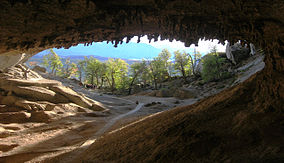- Cueva del Milodón Natural Monument
-
Cueva del Milodón Natural Monument
Mylodon's CaveLocation Magallanes Region, Chile Coordinates 51°33′56″S 72°37′11″W / 51.56556°S 72.61972°WCoordinates: 51°33′56″S 72°37′11″W / 51.56556°S 72.61972°W Governing body Corporación Nacional Forestal Cueva del Milodón Natural Monument is a Natural Monument located in the Chilean Patagonia,[1] 24 km (15 mi) northwest of Puerto Natales and 270 km (168 mi) north of Punta Arenas. The monument is situated along the flanks of the Cerro Benitez Mountains.[2] It comprises several caves and a rock formation called Silla del Diablo (Devil's Chair).
The monument is notable for the discovery in 1896 of skin, bones and other parts of a giant ground sloth called Mylodon (Mylodon darwini).
At the entrance of the monument is a life size replica of the prehistoric Milodon, which was a very large herbivore, somewhat resembling a large bear. It became extinct at the end of the Pleistocene Epoch.
Contents
Milodon Remains
Investigations determined the survival of the Milodon until about 5,000 years ago and confirmed the existence of other animals, such as the "Dwarf Horse", the Smilodon and the Great Guanaco denominated "Macraucheria"[3]
Human Remains
Diverse elements of human habitation are found[4] at Cueva del Milodon including fire fractured rock, lithic tools and human remains. Human habitation at Cueva del Milodon is dated as early as 6000 BC.[5]
See also
- Cerro Toro
- Eberhard Fjord
- Hippidion saldiasi
References
- ^ Ciudad de Puerto Natales: Cueva del Milodon
- ^ C. Michael Hogan, Cueva del Milodon, Megalithic Portal, 13 April 2008 [1]
- ^ Milodón's Cave in Letsgochile.com
- ^ [2]
- ^ Calvin J. Heusser (2003) ‘'Ice Age Southern Andes: A Chronicle of Paleoecological Events'‘, Elsevier, 240 pages ISBN:0444514783
 Natural Monuments of ChileAlerce Costero · Cerro Ñielol · Cinco Hermanas · Contulmo · Cueva del Milodón · Dos Lagunas · El Morado · Isla Cachagua · Islotes de Puñihuil · La Portada · Laguna de los Cisnes · Lahuen Ñadi · Los Pingüinos · Pichasca · Salar de Surire
Natural Monuments of ChileAlerce Costero · Cerro Ñielol · Cinco Hermanas · Contulmo · Cueva del Milodón · Dos Lagunas · El Morado · Isla Cachagua · Islotes de Puñihuil · La Portada · Laguna de los Cisnes · Lahuen Ñadi · Los Pingüinos · Pichasca · Salar de Surire
This article related to a protected area in South America is a stub. You can help Wikipedia by expanding it.

